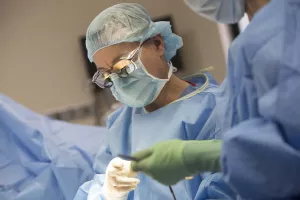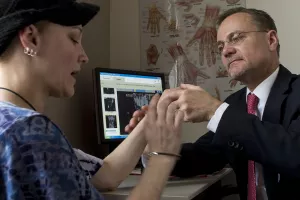When you suffer a broken bone, dislocated joint or torn ligament, it can be very painful and suddenly stop you in your tracks. Our orthopedic trauma specialists are on standby at our trauma centers within emergency departments, so you can receive the highest level of trauma care as soon as you need it.
Orthopedic trauma care delivered around the clock
Every minute counts when you’ve experienced a traumatic orthopedic injury. That’s why our orthopedic trauma team is available 24/7.
You deserve access to the best in trauma care when and where you need it. For 1 local neighbor, that story unfolded as overcoming a broken femur to complete the Boston Marathon only a year later. Another person survived a great white shark attack off the coast of Cape Cod and regained the strength to walk for miles a mere year after undergoing 9 surgeries to repair their damaged leg.
It’s our honor to be the partner you trust on the good days and the challenging ones. You can trust that you’ll have a whole care team of physicians, nurses, physical therapists and surgeons to help you get back on the path to better health.

Conditions
Orthopedic trauma covers a wide range of services, from basic fractures to bone infections. You can feel confident knowing we’re qualified to treat all levels of injuries, including the most life-threatening.
Turn to our orthopedic surgical staff when you’ve experienced fractures to the:
- Acetabulum (socket of the hip joint)
- Clavicle
- Joints
- Lower extremities
- Pelvis
- Shoulder
- Upper arm
Sometimes, previous fractures that didn’t heal properly can become problematic. This ranges from:
- Fractures that became infected (like osteomyelitis)
- Fractures that healed poorly (non-union)
- Fractures that settled in the wrong position (mal-union)
What is osteomyelitis?
Osteomyelitis is the medical term for a bone infection. There are 2 types of osteomyelitis.
- Acute osteomyelitis: A new bone infection.
- Chronic osteomyelitis: When an open injury or wound near a bone allows bacteria to spread into the bone.
Chronic osteomyelitis can be caused by many different types of bacteria. This condition is more common in adults and tends to develop over 1 month or up to several years following an injury.
Bone infections can occur when:
- A break in the skin allows bacteria to spread into bone tissue
- An injury like a fracture, where the bone goes through the skin, exposes the bone to bacteria
- Bacteria from an infection in another part of the body spreads through the blood and infects the bone
Risk factors for osteomyelitis include:
- A broken bone that initially came through the skin
- A skin infection
- An infection anywhere in your body
- An open wound near a bone
- Surgery
- Surgery using orthopedic hardware like metal pins or plates
Treatments
In addition to our surgeons, our entire orthopedic trauma team is ready to help you. Your care team includes:
- Attentive and caring support staff who can assist with processing paperwork and answer questions on postoperative recovery.
- Specialists in orthopedic casting and custom braces.
- Physical therapists who excel in helping you return to your everyday activities as soon as possible.
The way we treat your fracture depends on the type of fracture and its location. If you have an open wound with your fracture, you may need treatment to control bleeding or prevent infection.
If your broken bone is crooked, our orthopedic specialists will straighten it by moving the pieces into their proper places. This may be done with minimally invasive techniques or surgery.
Minimally invasive treatments
Whenever possible, we'll use minimally invasive approaches to treat your condition. These include:
- Closed reduction: Moves bones back into position without cutting through the skin.
- Traction: Uses weights or elastic bands to pull the bone into place. Traction also helps stabilize the bone while it heals.
- Cast or splint: Some fractures need only rest and ice, as well as a possible brace, boot, splint or cast to support and stabilize the broken bones while they heal.
Surgery
Sometimes, a surgical approach known as open reduction and internal fixation (ORIF) is required to reset and stabilize a broken bone. After we return your bones to their proper places, we may use hardware like metal pins, plates, rods or screws to create a frame. This frame acts as a support system around the fracture to hold the bones in position as they heal.
Depending on the severity of your injury, we may remove the metal frame after your bone has healed or leave it in your body.
Physical therapy
Your care team may recommend physical therapy to strengthen your muscles and joints following an injury. We offer inpatient and outpatient physical therapy.
Inpatient care
Some roads to recovery require around-the-clock care in a hospital environment, especially if you've experienced a(n):
- Hip and knee replacement
- Injury resulting from a car accident or other traumatic event
Our physical therapists will work with you and the rest of your care team so that you can head home or to the next destination in your rehabilitation journey.
Outpatient care
Physical therapy that doesn't require an overnight stay in the hospital is called outpatient care. This type of physical therapy is common for conditions affecting your mobility, like:
- Arthritis
- Back and neck pain
- Sports injuries
Treating osteomyelitis
How we treat your osteomyelitis depends on how severe your condition is. Certain cases can be taken care of with antibiotics. More severe cases may require surgery to fast-track your path to wellness.
During surgery, your orthopedic surgeon will:
- Open the infected area around the bone and remove any dead tissue or bone
- Surgically reconstruct the bone if large pieces have died
- Surgically cover any areas of exposed bone or deep soft tissues as needed

From regular office visits to inpatient stays, find the healthcare you need and deserve close to home.

Meet the doctors and care team devoted to supporting you every step of the way along your path to better health.